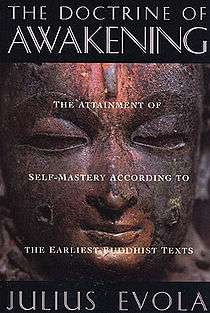The Doctrine of Awakening

The Doctrine of Awakening: The Attainment of Self-Mastery According to the Earliest Buddhist Texts is a book by philosopher and esotericist Julius Evola. The book was first published in Italian as La dottrina del risveglio in 1943. It was translated into English in 1948 by H.E. Musson, and republished in 1997 (ISBN 0-89281-553-1).
Summary
Part I: Principles
Part I of the book is dedicated to establishing the history and development of ancient Buddhism. Chapter 5 goes on to discusses the notion of Samsara, and describe Buddhist self-mastery as a tiered process of self overcoming and eventual extinction. In Chapter 6, Evola outlines the Buddhist conception of "Conditioned Genesis," or Pratītyasamutpāda, the process through which every living entity is thought to come into being. Conditioned Genesis is highly structured, and entails 12 formal steps, or nidanas.[1]
Part II: Practice
Part II of the book departs from formal definitions and attempts to aid the reader in integrating an ancient Buddhist outlook into modern life. Throughout this section, Evola is ardent in his claim that the modern world is one of spiritual crisis, and he positions self-mastery through Buddhism as a potential solution.[2]
References
- ↑ Evola, Julius (1997). The Doctrine of Awakening. Rochester, Vermont: Inner Traditions. pp. 0–92. ISBN 0-89281-553-1.
- ↑ Evola, Julius (1997). The Doctrine of Awakening. Rochester, Vermont: Inner Traditions. pp. 93–246. ISBN 0-89281-553-1.
External links
- Review of The Doctrine of Awakening by Richard Smoley in Parabola magazine.
- Publisher's blurb for The Doctrine of Awakening by Inner Traditions
- Discussion on The Doctrine of Awakening's translator: Captain Harold Musson